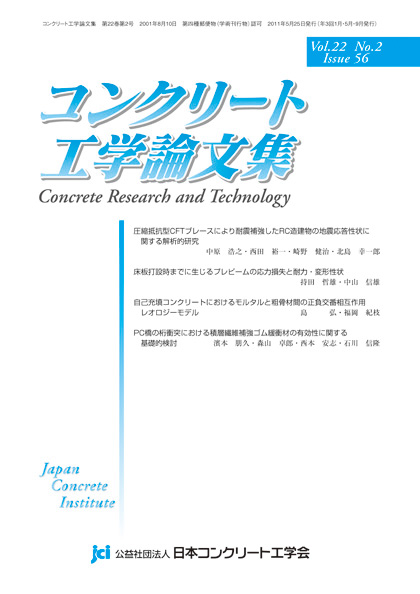All issues

Volume 20 (2009)
- Issue 3 Pages 3_1-
- Issue 2 Pages 2_1-
- Issue 1 Pages 1_1-
Volume 20, Issue 2
Displaying 1-4 of 4 articles from this issue
- |<
- <
- 1
- >
- >|
-
Takahiro Kanno, Tadayoshi Ishibashi, Junichi Kino, Kaoru Kobayashi2009Volume 20Issue 2 Pages 2_1-2_12
Published: 2009
Released on J-STAGE: December 22, 2011
JOURNAL FREE ACCESSWe usually design the reinforced concrete viaduct for railway so that the viaduct has hight defomation capacity to resist big earthquake. So we have studied the reinforced concrete column reinforced by inside spiral reinforcement. But we have not studied fully the deformation capacity of this column. So we studied the deformation capacity and estimation method of this column by reversal cyclic loading test. In this paper, we mainly report on the deformation capacity and propose the estimation method of this column by the results of revesal cyclic loading test.View full abstractDownload PDF (769K) -
Yasuhiro Dosho2009Volume 20Issue 2 Pages 2_13-2_26
Published: 2009
Released on J-STAGE: December 22, 2011
JOURNAL FREE ACCESSIn order to build the recycling system of concrete waste, a primary review for applicability of recycled aggregate concrete to the precast reinforced concrete products has been carried out. The review results have confirmed that the properties such as durability of recycled aggregate concrete can be improved by steam curing and reuse of recycled aggregate concrete is applicable through suitable quality control. And these results have proven that recycled aggregate concrete produced by aggregate replacing can be manufactured through material design that was using the value of relative quality with sufficient quality as precast reinforced concrete products by using materials that conform to all the related quality standards.View full abstractDownload PDF (1739K) -
Kyoji Niitani, Hiroshi Watase, Kenji Sakata, Toshiki Ayano2009Volume 20Issue 2 Pages 2_27-2_37
Published: 2009
Released on J-STAGE: December 22, 2011
JOURNAL FREE ACCESSNumbers of concrete structures have been constructed and they contribute to creation of infrastructures. It is important to know the stress of concrete acting on existing structures in order to maintain structures appropriately. However, it is difficult to know the actual stress for several reasons. The major reason is differences between the design stress conditions and the actual stress conditions. The causes are internal restrictions due to creep and shrinkage of concrete. In this study, the mechanisms of internal restrictions are investigated through various experiments on creep and shrinkage of concrete, and a new effective stress estimation method is proposed. The method is based on stress release technique. It can separate stresses caused by internal restriction from the total stress. Also, the accuracy of estimated stress has been improved by providing a specified measuring method. From verification tests using test specimens and actual structures, it was confirmed that the method is useful for setting maintenance level of structures.View full abstractDownload PDF (1674K) -
Hideyuki Utsumi2009Volume 20Issue 2 Pages 2_39-2_49
Published: 2009
Released on J-STAGE: December 22, 2011
JOURNAL FREE ACCESSA mathematical expression of the diffusivity coefficients for the vapor and liquid phase of water in cementitious materials has been developed that depends on the adsorption amount. This expression has been formulated based on a thermodynamic equation of the state by which to express the progress of the water adsorption phenomenon in pore spaces, and uses the new adsorption isotherm reflecting the characteristics of the pore size distribution of cementitious materials. This expression enables one to express quantitatively the influence produced by the change of temperature and pore size distribution on the diffusivity coefficients of each phase. The analysis results show a valid correlation with the previous studies, and clarifies that the principal factors of the water transfer phenomenon changes from the vapor phase transfer to the liquid phase transfer with the increase of the amount of adsorption.View full abstractDownload PDF (655K)
- |<
- <
- 1
- >
- >|